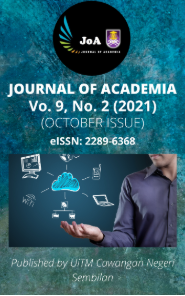DRIVERS OF CAPITAL STRUCTURE IN MALAYSIA REAL ESTATE INVESTMENT TRUST FUNDS (M-REITs)
Keywords:
Real Estate Investment Trust Funds, capital structure, pecking order theory, trade-off theory, M-REITsAbstract
This study investigates drivers of capital structure decisions of Malaysian Real Estate Investment Trust
Funds (M-REITs) using 121 observations from 15 REITs companies listed in the Bursa Malaysia during
8 years study period of 2011 to 2018. Employing the panel data regression model, the result indicates
that operating risk is significantly negatively related to leverage suggesting that M-REIT firms with
higher uncertainty of earnings opt for low leverage as it reduces their risk of bankruptcy. Consistent
with pecking order theory, profitability is reported to have significantly negatively related to leverage
implying that M-REITs with higher (lower) profits have lower (larger) debt albeit this industry is
expected to have low retained earnings. Contrary to the trade-off theory, the asset tangibility is
significantly negatively related to leverage indicating that M-REITs with higher fixed assets opt for
lower debt. The uniqueness of M-REIT regulation could be the justification for this result.
References
Abdul Jalil R., and Mohd Ali, H. (2015). Performance determinants of Malaysian Real Estate Investment Trusts.
Jurnal Teknologi, 73(5), 151-159.
Alcock J., Steiner, E., and Tan, K. J. K. (2010). Joint leverage and maturity choices in real estate firms: the role
of the REIT status. The Journal of Real Estate Finance and Economics, 48, 57-78.
Brown, D. T., and Riddiough, T. J. (2003). Financing choice and liability structure of Real Estate Investment
Trusts. Real Estate Economics, 31, 313-346.
Chikolwa, B. (2011). Investigating the capital structure of A-REITs. Journal of Real Estate Literature, 19(2), 391
De Jong, A., Kabir, R., and Nguyen, T. T. (2008). Capital structure around the world. The roles of firm and country
specific determinants. Journal of Banking and Finance, 32(9), 1954-1969.
Ertugrul, M., and Giambona, E. (2010). Property segment and REIT capital structure. The Journal of Real Estate
Finance and Economics, 43(4), 505-526.
Feng, Z., Ghosh C., and Sirmans, C. F. (2007). On the capital structure of Real Estate Investment Trusts (REITs).
Journal of Real Estate Finance and Economic, 34(1), 81–105.
Harris, M., and Raviv, A. (1991). The theory of capital structure. the Journal of Finance, 46(1), 297-355.
Harrison, D. M., Panasian, C. A. and Seiler, M. J. (2011). Further evidence on the capital structure of REITs.
American Real Estate and Urban Economics Association, 39(1), 133-166.
Juillet, F. (2012). Analysis of the Real Estate Investment Trust (REIT) industry. Unpublished MBA thesis. Johnson
and Wales University ScholarsArchive@JWU.
Lips, B., and Schramade, W.L.J. (2009). The Capital Structure: An Alternative Explanation.
https://pdfs.semanticscholar.org/a8fe/2380b168b2b7c35eb6e9fb1208a641437b13.pdf (access online 28 August
Modigliani, F., and Miller, M. H. (1958). The cost of capital, corporation finance and the theory of investment.
American Economic Review, 48(3), 261-97.
Morri, G., and Beretta, C. (2008). The capital structure determinants of REITs. Is it a peculiar industry? Journal
of European Real Estate Research, 1(1), 6-57.
Morri, G., and Cristanziani, F. (2009). What determines the capital structure of real estate companies? An
analysis of the EPRA/NAREIT Europe Index. Journal of Property Investment and Finance, 27(4): 318-372.
Myers, S.C., and Majluf, N.S. 1984. Corporate Financing and Investment Decisions When Firms Have
Information that Investors Do Not Have. Journal of Financial Economics, 13(2), 187 221.
Ott, S. H., Riddiough, T .J. and Yi, H. (2005). Finance, Investment and Investment Performance: Evidence from
the REIT Sector. Real Estate Economics, 33(1), 203–235.
Zainudin, Z., Hussain, H. I., Ibrahim, I, and Mohd Said, R. (2017). Debt and financial performance of REITs in
Malaysia: A moderating effect of financial flexibility. Journal Pengurusan, 50, 3-12.
Zarebski, P., and Dimovski, B. (2012). Determinants of capital structure of A-REITs and the global financial
crisis. Pacific Rim Property Research Journal. 18(1), 3-19.
https://www.theedgemarkets.com/article/msian-reits-could-become-market-darlings-2019, retrieved June 29,
Downloads
Published
Issue
Section
License
Copyright (c) 2021 Journal of Academia

This work is licensed under a Creative Commons Attribution-NonCommercial-NoDerivatives 4.0 International License.












